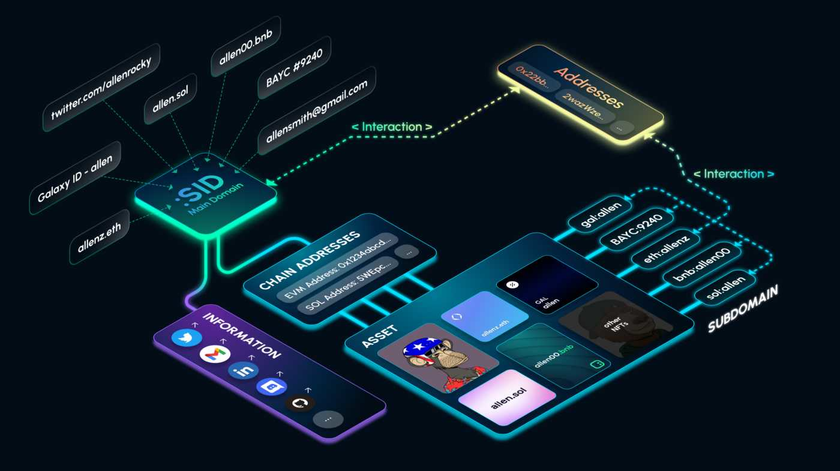SpaceID: Offering Users a .BNB Multi-Chain Identity
SpaceID is offering users a Web3 identity they can utilize in navigating the metaverse, trading cryptos, lending tokens, minting NFTs and enjoying the opportunities to come using a convenient ID.
The open source blockchain-based universal name service network seamlessly connects people, information, assets, and applications in the digital world. It is chain-agnostic, decentralized, censorship-resistant, and open-sourced. What this means is that as you move through Web3, navigating between your favoured dApps you can do so all within the realms of your own certified name.
For Web3 to continue on its path as a burgeoning space that will onboard new unfamiliar users, it will need to allow for identity interactions whereby users can be recognized, interact with one another and display their online identities. In the end we all prefer interacting with people as opposed to addresses, right? To make this a reality a universal identifier like SpaceID working across chains becomes pivotal.
The current Web3 reality sees users adopting several identities and usernames across the multitude of applications and blockchains they interact with. The current list of different identifiers for most people involves the following: legal name, email address, Twitter handle, BNB Chain address, addresses of other chains they interact with and it goes on from there… All this before we even get onto applications.
For dApps on blockchains to thrive and enhance operability there will need to be a way to be way of employing universal identification- SpaceID is offering a solution for this. The project outlines that your own SpaceID (SID) will be far more than just a name, it represents your Web3 identity as you move through and enjoy the entirety of the space,
But we’ve Seen Domain Services Before..
With other domain services the initial issue is that they are often segregated and limited to the specific blockchain they operate on. The lack of decentralization in the connector between blockchain identifiers isolates these even more.
The domains themselves are often a free-for-all, whereby we see malicious actors attempt to adopt well-known brands. Complex registration systems means the process isn’t accessible to new Web3 users. Integration for protocols has also proven to be a difficult prospect so far, meaning that domain services thus far have operated solely as name services making them less attractive.
How Does SpaceID Differ?
SpaceID has been outspoken in their belief that the core of Web3 is to become the gateway between decentralized identities and the physical/digital world, and the key is finding solutions to the challenges that all the current domain services are facing.
In their attempts to find a solution the team has constructed three primary features:
Feature 1: Universal Domain
Build your brand: Users will have no reason to worry about adopting different names on different chains, SpaceID a unique identity to all chains.
Superior naming layout: As a multichain name service aggregator, SpaceID were after a more encompassing structure, along with a way to separate Top-Level-Domains from User domains. This is their solution “:” XX: for TLDs and :XX for Users.
Simplify interactions: A huge plus for people navigating the space will be the fact they no longer need to triple or quadrouple-check the address they are intercting with. SPACE ID allows users to adopt the same name across chains.
Connect your identifiers: Another enticing feature for bringing on the next wave of Web3 users comes in the fact that SPACE ID allows users to connect their identities from the Web2 world, whether it's an email address a Twitter etc..
Feature 2: Customized Top-Level-Domains
Unique usernames for communities: The team has also looked to appeal to the needs of users who want to retain multiple identities for different communities. Having the choice, is what matters they claim. Therefore, SPACE ID supports customized TLDs in the form of BAYC: or ETH: which the latter would be the equivalent of .eth.
Seamless NFT integration: A quick example to better illustrate this: let’s say BAYC wants to airdrop more $APE coins to their holders, all they have to do is send funds to all the BAYC:XX subdomains. You do not have to know their other aliases or even their universal name, it will automatically be sent to the owner address of BAYC:XX.
Combination of TLDs & multi-chain: SpaceID underline that there are many advantages to combining TLDs and a multi-chain domain service. If a universal domain is set to :Allen, he can also set his identities to:
-
BAYC:001
-
ETH:Allen (allen.eth)
-
BNB:Denali (denali.bnb)
-
On Twitter, if that user is @Allen, well then he could use Twitter:Allen as one of his domain to interact with as well. And since everything is tied up together this way, it also means a user can send crypto on the Solana Blockchain, to a .bnb domain.
Feature 3: One SDK for All
Fast implementation: This is how SpaceID hope to make integrations easy for partners, with the SPACE ID SDK only take 30 minutes.
Name service aggregator: SPACE ID has TLDs that can be used to resolve other domains and name services. This means developers only have to integrate SpaceID's SDK in order to have integrated with all the other main name services out there.
Last Thoughts
While identity remains a key part of engaging social interactions on Web3 and opening the space up, the determining factor will be the integration of applications that see the highest usage. Users can pick up their own domains at a cost of $5 a year with relatively low gas fees. Reach out and let us know if you’ll be picking up your very own .BNB identity.
https://www.bnbchain.org/en/blog/spaceid-offering-users-a-bnb-multi-chain-identity/





























